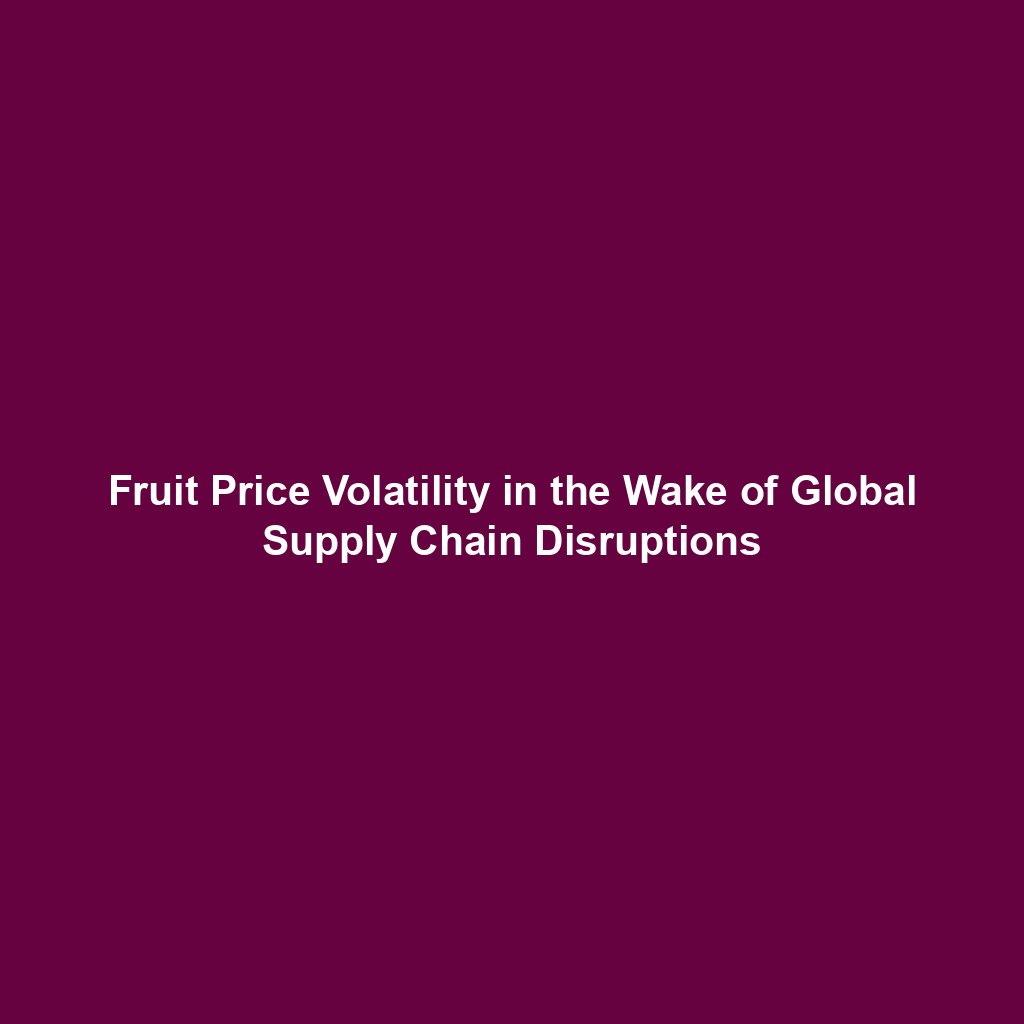
Fruit Price Volatility in the Wake of Global Supply Chain Disruptions has become a critical issue for both consumers and producers. The agricultural sector, particularly the fruit market, has been significantly impacted by various global events that have disrupted supply chains, leading to unpredictable price fluctuations. This article delves into the complexities of agricultural price analysis, focusing on the factors contributing to fruit price volatility and the implications for stakeholders.
Chapter 1: Understanding Agricultural Price Volatility
Introduction to Agricultural Price Volatility
Agricultural price volatility refers to the frequent and unpredictable changes in the prices of agricultural commodities. This volatility can be attributed to a myriad of factors, including weather conditions, pest infestations, market demand, and global trade policies. In the context of fruit markets, price volatility can have far-reaching consequences, affecting everything from farm incomes to consumer prices.
Factors Contributing to Price Volatility
Several key factors contribute to the volatility of fruit prices:
- Weather Conditions: Extreme weather events such as droughts, floods, and hurricanes can severely impact fruit production, leading to supply shortages and price spikes.
- Pest and Disease Outbreaks: Infestations and diseases can devastate fruit crops, reducing yields and increasing prices.
- Market Demand: Changes in consumer preferences and demand can lead to price fluctuations. For example, a sudden increase in demand for a particular fruit can drive up prices.
- Global Trade Policies: Tariffs, trade agreements, and export restrictions can influence the availability and cost of imported fruits, affecting domestic prices.
- Supply Chain Disruptions: Events such as transportation strikes, port closures, and logistical challenges can disrupt the flow of goods, leading to price volatility.
Impact on Stakeholders
The volatility of fruit prices has significant implications for various stakeholders:
- Farmers: Price volatility can affect farmers’ incomes and financial stability. Sudden price drops can lead to losses, while price spikes can benefit producers but may also lead to increased production costs.
- Consumers: Fluctuating fruit prices can impact household budgets and food security. High prices may limit access to nutritious fruits, particularly for low-income families.
- Retailers: Retailers must navigate price volatility to maintain profitability. They may need to adjust pricing strategies and manage inventory levels to mitigate the impact of price changes.
- Policymakers: Governments and policymakers must address the challenges posed by price volatility through measures such as subsidies, price controls, and support programs for farmers.
Chapter 2: Analyzing Fruit Price Volatility
Data Collection and Analysis
Effective analysis of fruit price volatility requires comprehensive data collection and analysis. Key data sources include:
- Market Prices: Historical and current market prices for various fruits provide insights into price trends and volatility.
- Production Data: Information on fruit production volumes, yields, and acreage helps assess supply-side factors influencing prices.
- Weather Data: Weather patterns and forecasts are crucial for understanding the impact of climatic conditions on fruit production and prices.
- Trade Data: Import and export data reveal the influence of global trade on domestic fruit prices.
- Consumer Demand: Surveys and market research provide insights into consumer preferences and demand trends.
Analytical Methods
Several analytical methods can be employed to study fruit price volatility:
- Time Series Analysis: This method involves analyzing historical price data to identify trends, patterns, and seasonal variations.
- Econometric Models: Econometric models use statistical techniques to quantify the relationships between price volatility and various factors such as weather, production, and trade.
- Scenario Analysis: Scenario analysis involves simulating different scenarios to assess the potential impact of various factors on fruit prices.
- Risk Assessment: Risk assessment techniques help identify and quantify the risks associated with price volatility, enabling stakeholders to develop mitigation strategies.
Case Studies
Examining specific case studies can provide valuable insights into the dynamics of fruit price volatility:
- Case Study 1: The Impact of Hurricanes on Citrus Prices: This case study explores how hurricanes in major citrus-producing regions have led to supply shortages and price spikes.
- Case Study 2: The Role of Trade Policies in Apple Price Volatility: This case study examines how changes in trade policies, such as tariffs on imported apples, have influenced domestic apple prices.
- Case Study 3: The Effect of Consumer Demand on Avocado Prices: This case study analyzes how the growing popularity of avocados has driven up prices and led to increased production.
Strategies for Managing Price Volatility
Stakeholders can adopt various strategies to manage and mitigate the impact of fruit price volatility:
- Diversification: Farmers can diversify their crop portfolios to reduce dependence on a single fruit and spread risk.
- Contract Farming: Contract farming arrangements can provide farmers with price stability and guaranteed markets for their produce.
- Storage and Preservation: Investing in storage and preservation technologies can help manage supply fluctuations and stabilize prices.
- Market Information Systems: Access to timely and accurate market information can help stakeholders make informed decisions and respond to price changes effectively.
- Policy Interventions: Governments can implement policies such as price supports, subsidies, and crop insurance programs to protect farmers and consumers from price volatility.
Conclusion
Fruit price volatility in the wake of global supply chain disruptions presents significant challenges for the agricultural sector. Understanding the factors contributing to price volatility and employing effective analytical methods are crucial for managing its impact. By adopting strategies such as diversification, contract farming, and policy interventions, stakeholders can mitigate the risks associated with price fluctuations and ensure a more stable and resilient fruit market. As global supply chains continue to evolve, ongoing research and collaboration among stakeholders will be essential to address the complexities of agricultural price volatility and promote sustainable agricultural practices.



